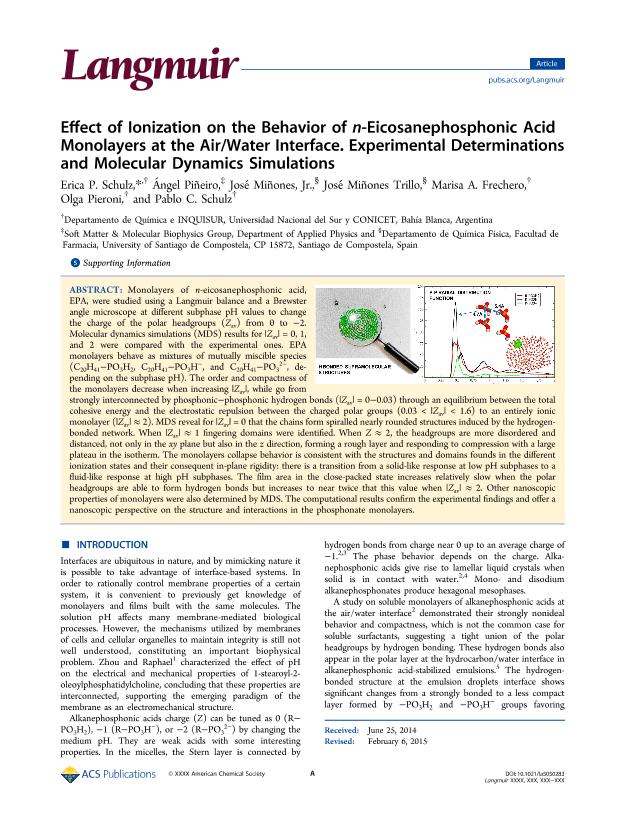Artículo
Effect of ionization on the behavior of n-Eicosanephosphonic acid monolayers at the air/water interface. experimental determinations and molecular dynamics simulations
Schulz, Erica Patricia ; Piñeiro, Ángel; Miñones, José; Miñones Trillo, José; Frechero, Marisa Alejandra
; Piñeiro, Ángel; Miñones, José; Miñones Trillo, José; Frechero, Marisa Alejandra ; Pieroni, Olga Inés; Schulz, Pablo Carlos
; Pieroni, Olga Inés; Schulz, Pablo Carlos
 ; Piñeiro, Ángel; Miñones, José; Miñones Trillo, José; Frechero, Marisa Alejandra
; Piñeiro, Ángel; Miñones, José; Miñones Trillo, José; Frechero, Marisa Alejandra ; Pieroni, Olga Inés; Schulz, Pablo Carlos
; Pieroni, Olga Inés; Schulz, Pablo Carlos
Fecha de publicación:
03/2015
Editorial:
American Chemical Society
Revista:
Langmuir
ISSN:
0743-7463
Idioma:
Inglés
Tipo de recurso:
Artículo publicado
Clasificación temática:
Resumen
Monolayers of n-eicosanephosphonic acid, EPA, were studied using a Langmuir balance and a Brewster angle microscope at different subphase pH values to change the charge of the polar headgroups (Zav) from 0 to -2. Molecular dynamics simulations (MDS) results for |Zav| = 0, 1, and 2 were compared with the experimental ones. EPA monolayers behave as mixtures of mutually miscible species (C20H41-PO3H2, C20H41-PO3H-, and C20H41-PO32-, depending on the subphase pH). The order and compactness of the monolayers decrease when increasing |Zav|, while go from strongly interconnected by phosphonic-phosphonic hydrogen bonds (|Zav| = 0-0.03) through an equilibrium between the total cohesive energy and the electrostatic repulsion between the charged polar groups (0.03 < |Zav| < 1.6) to an entirely ionic monolayer (|Zav| ≈ 2). MDS reveal for |Zav| = 0 that the chains form spiralled nearly rounded structures induced by the hydrogen-bonded network. When |Zav| ≈ 1 fingering domains were identified. When Z ≈ 2, the headgroups are more disordered and distanced, not only in the xy plane but also in the z direction, forming a rough layer and responding to compression with a large plateau in the isotherm. The monolayers collapse behavior is consistent with the structures and domains founds in the different ionization states and their consequent in-plane rigidity: there is a transition from a solid-like response at low pH subphases to a fluid-like response at high pH subphases. The film area in the close-packed state increases relatively slow when the polar headgroups are able to form hydrogen bonds but increases to near twice that this value when |Zav| ≈ 2. Other nanoscopic properties of monolayers were also determined by MDS. The computational results confirm the experimental findings and offer a nanoscopic perspective on the structure and interactions in the phosphonate monolayers.
Palabras clave:
Ionization
,
Behavior
,
Phosphonic Acid
,
Monolayers
Archivos asociados
Licencia
Identificadores
Colecciones
Articulos(INQUISUR)
Articulos de INST.DE QUIMICA DEL SUR
Articulos de INST.DE QUIMICA DEL SUR
Citación
Schulz, Erica Patricia; Piñeiro, Ángel; Miñones, José; Miñones Trillo, José; Frechero, Marisa Alejandra; et al.; Effect of ionization on the behavior of n-Eicosanephosphonic acid monolayers at the air/water interface. experimental determinations and molecular dynamics simulations; American Chemical Society; Langmuir; 31; 8; 3-2015; 2269-2280
Compartir
Altmétricas



